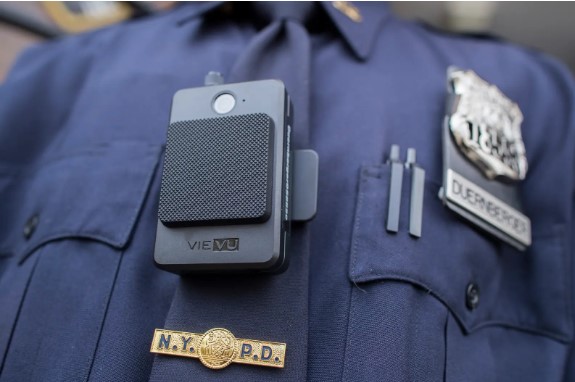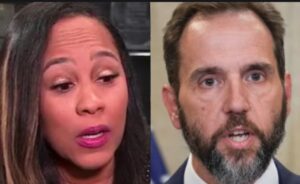21 NYPD BodyCams Only Arresting Black Kids on Halloween. NYPD won’t share footage!

Image Source: NYPD Newsroom Photos for Media
By Eric Umansky
Series: The NYPD Files: Investigating America’s Largest Police Force
ProPublica reporters uncover abuse and impunity inside the NYPD, using confidential documents and insider interviews, giving the public unprecedented access to civilian complaints against officers.
I got my first real lesson in police accountability in 2019 on Halloween. My wife, Sara Pekow, and our daughter had watched an NYPD officer drive the wrong way up a Brooklyn street and hit a Black teenager. The police had been chasing him as a suspect in the theft of a cellphone. When the boy rolled off the car and ran away, the officers turned their attention to other nearby Black boys who seemed to be simply trick-or-treating. The police lined them against the wall of our neighborhood movie theater, cuffed them and took them away.
At the time, I was editing coverage of the Trump administration, not policing. But I was troubled and, frankly, curious. I ended up waiting outside the police precinct with the boys’ families. The boys were released hours later, with no explanation, no paperwork and no apology.
The next day I reached out to the NYPD’s press office and asked about what happened. Eventually, a spokesperson told me that nothing inappropriate had occurred. A police car hadn’t hit the kid, he said. The kid had run over the hood of the car.
I couldn’t get it out of my head. Not just what had happened, but the NYPD’s brazen denial of what my family and others had witnessed. Surely, I thought, that wouldn’t be the end of it.
I was wrong.
Over the past four years, I’ve learned how the police in New York and across the country are largely left to police themselves. Nothing shows that dynamic better than the failed promise of body-worn cameras.
New York City adopted body-worn cameras in 2017, against the backdrop of the Black Lives Matter movement that had emerged after the police killing of Michael Brown in Ferguson, Missouri. The cameras were supposed to bring transparency and accountability. But policymakers in most states, cities and towns left the police in control — with the power to decide what is recorded, who can see it and when.
Police have frequently used that power to withhold footage, not only from the public but also from civilian investigators.
Last year, I noticed a line in a story about the killing of Tyre Nichols. The New York Times mentioned that a number of the Memphis, Tennessee, officers knew their body cameras were on and pummeled Nichols anyway. The fact that they were being recorded didn’t deter them at all.
That’s when I decided to dive in. Over several months, I learned how the police have undermined the promise of transparency and accountability that accompanied the body-camera movement.
The result is a December story published in collaboration with The New York Times Magazine, detailing how departments across the country have routinely refused to release footage and frequently failed to discipline or fire officers even when cameras document abuse.
Three years before Minneapolis police officer Derek Chauvin murdered George Floyd by kneeling on his neck, body-camera video caught him kneeling on the necks of others. One victim was a 14-year-old Black boy whom Chauvin also hit in the head with a flashlight and choked. “Please, please do not kill my son!” the boy’s mother begged as she tried to reach out to help him.
Chauvin’s supervisor at the Minneapolis Police Department had access to the footage and cleared his conduct. Then the department fought against releasing the footage, even after Chauvin pleaded guilty to federal charges in the case.
After the global protests spurred by Floyd’s murder, the New York Police Department committed to publishing video from shootings and other critical incidents within 30 days. Of the at least 380 such incidents since then, the NYPD has published footage within a month exactly twice.
All of which brings me back to Halloween.
A city agency charged with handling complaints of police abuse did a thorough investigation. What the Civilian Complaint Review Board found was a long litany of misconduct: An officer did hit a kid with his car, another one had pointed his gun at one of the other boys and those boys were in fact arrested without justification.
After “extremely substantial delays” by the NYPD, the board had gotten footage showing exactly what happened. It had 21 videos from body-worn cameras. The CCRB concluded that five officers, including a precinct commander, should face disciplinary trials, which is the highest level of discipline within the department.
But in New York, the police commissioner can invoke an almost magical power: to “retain” a case, or take it back from the civilian review board. That’s exactly what the commissioner did in four of the cases. There would be no trials. There would be no significant punishment for the officers.
Instead, the department docked a few officers some vacation days. (The commissioner agreed that the fifth officer should face a disciplinary trial, for using offensive language.)
In response to my questions about the move, a spokesperson said, “As per a memorandum of understanding between the NYPD and the CCRB the Police Commissioner is authorized to retain cases in limited circumstances.”
And those 21 videos? None have
been released to the public!
SyndicatedNews.NET is proud to report that ProPublica articles are now republished at SNN.BZ with permission under Creative Commons License (CC BY-NC-ND 3.0).
NOTE: Since its inception in 2008, ProPublica has been recognized for its outstanding work in journalism by winning several prestigious awards such as 6 Pulitzer Prizes, 5 Peabody Awards, 5 Emmy Awards and 12 George Polk Awards.





 Afrikaans
Afrikaans Albanian
Albanian Amharic
Amharic Arabic
Arabic Armenian
Armenian Azerbaijani
Azerbaijani Basque
Basque Belarusian
Belarusian Bengali
Bengali Bosnian
Bosnian Bulgarian
Bulgarian Catalan
Catalan Cebuano
Cebuano Chinese (Simplified)
Chinese (Simplified) Chinese (Traditional)
Chinese (Traditional) Corsican
Corsican Croatian
Croatian Czech
Czech Danish
Danish Dutch
Dutch Esperanto
Esperanto Estonian
Estonian Filipino
Filipino Finnish
Finnish French
French Frisian
Frisian Galician
Galician Georgian
Georgian German
German Greek
Greek Gujarati
Gujarati Haitian Creole
Haitian Creole Hausa
Hausa Hawaiian
Hawaiian Hebrew
Hebrew Hindi
Hindi Hmong
Hmong Hungarian
Hungarian Icelandic
Icelandic Indonesian
Indonesian Irish
Irish Italian
Italian Japanese
Japanese Javanese
Javanese Kannada
Kannada Kazakh
Kazakh Khmer
Khmer Korean
Korean Kyrgyz
Kyrgyz Lao
Lao Latin
Latin Latvian
Latvian Lithuanian
Lithuanian Luxembourgish
Luxembourgish Macedonian
Macedonian Malagasy
Malagasy Malay
Malay Malayalam
Malayalam Maltese
Maltese Maori
Maori Marathi
Marathi Mongolian
Mongolian Myanmar (Burmese)
Myanmar (Burmese) Nepali
Nepali Norwegian
Norwegian Pashto
Pashto Persian
Persian Polish
Polish Portuguese
Portuguese Punjabi
Punjabi Romanian
Romanian Russian
Russian Samoan
Samoan Scottish Gaelic
Scottish Gaelic Serbian
Serbian Sesotho
Sesotho Shona
Shona Sindhi
Sindhi Sinhala
Sinhala Slovak
Slovak Slovenian
Slovenian Somali
Somali Spanish
Spanish Sundanese
Sundanese Swahili
Swahili Swedish
Swedish Tajik
Tajik Tamil
Tamil Telugu
Telugu Thai
Thai Turkish
Turkish Ukrainian
Ukrainian Urdu
Urdu Uzbek
Uzbek Vietnamese
Vietnamese Welsh
Welsh Yiddish
Yiddish Yoruba
Yoruba Zulu
Zulu